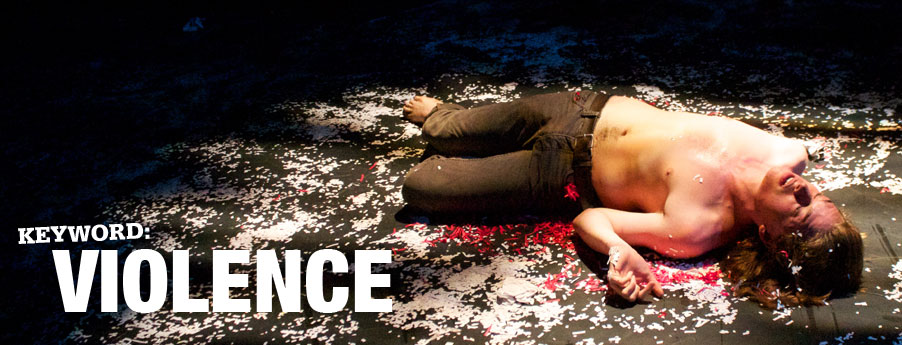Keyword: Violence
What role does violence play in human society? What role can the arts play in the search for an answer?
By Corinne Steinbrenner; Photo by Graham Edmondson (’13)
Jack leads his band of war-painted hunters in a rhythmic dance. As more boys join the circle, their stomping and chanting become louder, more fervent. “Kill the beast. Cut his throat. Spill his blood. Kill the beast. Cut his throat. Spill his blood.”
We’re midway through act two of the School of Theatre’s adaptation of William Golding’s 1954 novel, Lord of the Flies, the tale of a group of British schoolboys who devolve into a tribe of savages after being marooned on a lonely island. The mood in the small black-box theatre is tense; even audience members who read Lord of the Flies in high school and know how the scene plays out are holding their breath.
By the time the boys disperse, they have, indeed, killed—not the unknown beast that haunts their dreams, but Simon, one of their own.
“The play really dropped in for us, as a group, when we got to the staging of Simon’s death,” says Jake McLean (’12), who acted the part of Jack, the ringleader. “We all stepped out of that first day thinking, ‘Wow. That’s scary.’ We felt what it would be like to participate in such an act.”
After being cast as Jack, McLean began talking with his professors about techniques for cooling down, “shaking it off,” at the end of a rehearsal or performance. “If you’re doing a comedy and it brings you joy, you want to carry that into your life,” he says. “I don’t want to carry around murderous, angry, twelve-year-old.”
Playing Jack, who transforms from head choirboy to head hunter, was “quite a journey,” says McLean, “and I began to realize that a lot of his transformation comes out of fear—fear of disapproval and fear of the unknown. One thing that we discussed a lot with Jack is that whenever there’s a problem, he doesn’t think logically how to solve it. He just goes, ‘Okay, we’re going to go out and kill something now.’ That’s how he copes with things, with violence.”
Lord of the Flies’ exploration of violence is the reason it was chosen as part of the School of Theatre’s 2011–2012 lineup. This academic year is the inaugural year of the College of Fine Arts’ “keyword initiative,” which encourages CFA’s three schools to center their annual programming on a specific word. This year’s keyword: violence.
Catalyst for Conversation
Dean Benjamín Juárez hopes that CFA’s annual keyword efforts will strengthen ties among CFA’s three schools and spark conversations across campus. “We are trying to build a two-way dialogue with schools and colleges throughout BU, inviting our community to feel, think, and act around themes that are relevant to all of us,” he says, explaining that CFA is including experts from throughout BU in roundtables and lectures associated with CFA performances and exhibitions.
It’s an idea that has succeeded on other U.S. campuses. Since 2006, the University of Southern California has sponsored a university-wide arts initiative called Visions and Voices that explores the university’s core values (“search for truth,” “respect for diversity,” etc.) through performances, film screenings, lectures, and workshops. In 2007, the University of North Carolina at Chapel Hill launched Carolina Creative Campus, a program that uses the arts to catalyze campus discussion around a specific topic. In its first year, UNC chose the theme “Criminal/Justice: The Death Penalty.”
Reed Colver, who helped organize the UNC program, says that first theme turned out to be far more relevant to UNC than anyone expected. Partway through the academic year—just before a planned performance of Dead Man Walking, a play about a convicted murderer awaiting execution—UNC’s student body president was murdered. Because of the sensitivity of its subject, Creative Campus organizers considered cancelling the play, but they ultimately decided, says Colver, “We need to continue to provide the space that we’ve been providing for dialogue about these issues.” The structured discussions held in conjunction with the performances, she says, “gave students, faculty, and staff a chance to talk through and process, within a fairly safe environment, what was happening in our day-to-day lives.” Creative Campus became a perfect example of art’s power to build community and to help explore and explain the human condition.
Choosing Violence
The idea of using violence as CFA’s first keyword came during a visit to the gym last winter. “I was on the elliptical machine at the Y,” says School of Theatre Director Jim Petosa, “and the news reports about the shooting of Representative Gabby Giffords came on the air. It was such a stunning moment.”
The extensive news coverage of Giffords’s attempted assassination prompted Petosa to choose violence as a theme for his School’s coming year of theatrical programming. When he shared the idea with Juárez, the dean was so enthusiastic that he proposed extending the theme across CFA. “And then it became this notion of a keyword, which is different from a theme,” says Petosa. “A keyword actually suggests a Google way of thinking—cloud-based thinking—which is a much more generous way of examining the potency of a given word.”
Petosa and colleagues chose a range of plays for the School of Theatre’s exploration of violence—from Monster (an adaptation of Mary Shelley’s Frankenstein) to Shakespeare’s bloody revenge story Titus Andronicus. Fittingly, considering the event that inspired this examination of violence, the School is staging two plays that deal with political assassinations: Execution of Justice, the story of Dan White, who assassinated San Francisco’s openly gay city supervisor, Harvey Milk, and Assassins, a Stephen Sondheim musical that explores U.S. history through the eyes of people who either assassinated or attempted to assassinate U.S. presidents.
For its keyword programming, the School of Visual Arts invited controversial painter Enrique Chagoya to give November’s Contemporary Perspectives Lecture (see sidebar). While on campus, Chagoya made a series of small prints for the School inspired by Francisco Goya’s famous series, The Disasters of War. Visual arts professors leading junior and senior seminars are also incorporating the theme of violence into their course discussions this year.
Because opera so often deals with the extremes of human behavior, Opera Institute Director Sharon Daniels had no trouble selecting violence-themed operas to include in her 2011–2012 season, including Francis Poulenc’s Dialogues of the Carmelites, the story of 13 nuns sent to the guillotine during the French Revolution. BU Symphony Orchestra Conductor David Hoose also found he had plenty of material to choose from. “Unfortunately, violence is so omnipresent in our culture and our world,” he says, “that it’s something composers have responded to through a lot of music history.”
Hoose says that applying a keyword or other unifying concept to a season of programming is a wonderful idea that more arts organizations should consider. It’s particularly tricky, however, in a teaching environment. “The music that the orchestra plays or the chorus sings, that’s their curriculum,” he says, so while a keyword must be provocative enough to ignite conversation, it must also be broad enough to allow faculty to choose music, plays, and exhibits that will meet the educational needs of their students.
With these parameters in mind, CFA students and faculty members are already deep in discussion with professors and administrators from across BU, working to choose a fitting keyword for next year’s explorations.











April 27, 2012
Un articulo realmente interesante. La agrego a favoritos, no es facil encontrar rincones interesantes ultimamente.
May 17, 2013
beautiful post. thats exactly what a mom should be doing. my 3 are in their 20’s now, and I am their shadow. I HAVE to talk to them everyday either by phone or txt. I just HAVE to know that they are ok, and I HAVE to tell them I love them and am so proud of them. Because, you are right, we only have this moment. We don’t know what the next moment brings.